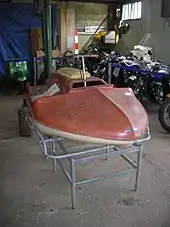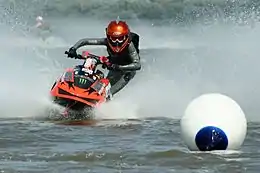Personal watercraft
A personal watercraft (PWC), also called water scooter, is a recreational watercraft that the rider sits or stands on, rather than inside of, as in a boat. PWCs have two style categories, first and most popular being a runabout or "sit down" where the rider uses the watercraft mainly sitting down, and the watercraft typically holds two or more people. The second style is a "stand-up", where the rider uses the watercraft standing up. The stand-up styles are built for one rider and are used more for doing tricks, racing, and use in competitions. Both styles have an inboard engine driving a pump-jet that has a screw-shaped impeller to create thrust for propulsion and steering. Most are designed for two or three people, though four-passenger models exist. Many of today's models are built for more extended use and have the fuel capacity to make long cruises, in some cases even beyond 100 miles (161 km).[1]
Personal watercraft are often referred by the trademarked brand names of personal watercraft by Kawasaki (Jet Ski), Yamaha (WaveRunner), Bombardier (Sea-Doo) and Honda (AquaTrax).
The United States Coast Guard defines a personal watercraft, amongst other criteria, as a jet-drive boat less than 13 feet (4 m) long.[2] There are many larger "jetboats" not classed as PWCs, some more than 40 feet (12 m) long.
History


Water scooters—as they were originally termed—were first developed in the United Kingdom and Europe in the mid-1950s, with models such as the British 200cc propellor-driven Vincent Amanda, and the German Wave Roller.[3][4] Two thousand Vincent Amandas were exported to Australia, Asia, Europe and the United States.[5] In the 1960s, the idea was developed further by Clayton Jacobson II of Lake Havasu City, Arizona, USA. Originally a motocross enthusiast,[6][7][8] Jacobson's idea was designed in the mid-1960s, powered by an internal pump-jet rather than an outboard motor,[8] made of all aluminum, and had a fixed, upright handle. Jacobson eventually quit his job in banking to devote himself to developing the idea, and had a working prototype by 1965. It differed slightly from modern personal watercraft but had definite similarities. He completed a second prototype a year later made of fiberglass.[9] The first Clayton-type PWC to reach the market was designed by Bombardier in the late 1960s.[10] Bombardier's original designs were not very popular and Bombardier left the business before 1970.
Stand-up PWCs were first produced by the Japanese company Kawasaki (under the Jet Ski brand) in 1972,[11] and appeared on the US market in 1973. These were mass-produced boats to be used by only one rider. While they are still produced today, the more popular design, is the sit down variety of PWC. These sit down runabouts have been produced by Kawasaki (Jetski), Bombardier (Sea-Doo), Yamaha (WaveRunner), Honda (AquaTrax), Polaris (Sealion) and Arctic Cat (Tigershark). As of 2010, the major manufacturers of PWCs were Kawasaki, Bombardier and Yamaha. Both Yamaha and Kawasaki continue to sell stand-up models but it is a small percentage of the overall market.
Sports

PWC racing competitions take place around the world.
The sport is ruled by the World Powerboating Federation (U.I.M.) recognised by the IOC. The current official world series that was established in 1996 is the Aquabike World Championship.[12] The sport is also established at national level and is ruled by each national federations member of the U.I.M. Aquabike World Championship is known among the motorsports with most different national entries for each competition, reaching up to 32 nationalities and 140 riders registered to compete in Italy on 2018. [13]
Other private competitions also exists such as P1 AquaX which is a personal watercraft racing series, first launched in the UK in May 2011 by London-based sports promoter Powerboat P1. The series attracted a mix of new and current racers to a new type of racing and in 2013, P1 rolled out a second series in the USA. Such was the uptake that the original format needed revising to cope with the influx of new riders and by the end of 2015 over 400 riders from 11 countries had registered to compete in an AquaX event.
Non-recreational uses



PWCs are small, fast, easily handled, fairly easy to use, affordable, and their propulsion systems do not have external propellers, making them safer for swimmers and wildlife. For these reasons, they are preferred for non-recreational use over small motorboats.
PWCs are used for Jet Ski fishing or PWC fishing and is the fastest growing segments in the industry. They are fast, safe and economical and are being chosen over traditional boats.
Lifeguards use PWCs equipped with rescue platforms to rescue water users who get into difficulties and carry them back to shore. Rescuers use PWCs to pick up flood survivors.
PWCs are used for law enforcement. Due to their speed and excellent maneuverability, police and rangers use them to enforce laws in coastal waters, lakes and rivers.
A PWC combined with a wash-reduction system, carrying waterproof loudspeaker equipment and GPS for instructions and distance measurement, has purportedly been used by assistant coaches for rowing sports on the River Tyne.
PWCs are used by the U.S. Navy as surface targets. Equipped with GPS, electronic compass, radar reflector, and a radio modem, the PWC is fully remotable with a two-way link. Its small shipboard footprint allows it to be stored and deployed from the smallest of vessels, and it has been used for target practice for everything from 5 in (13 cm) to small arms.
Emissions

The American PWC industry reached an agreement with the United States Coast Guard in 1999 (see fall, 1999 BSAC Minutes), agreeing to limit the speed of a PWC to 65 mph in a specified test protocol.
Before 1991, PWC emissions were unregulated in the United States. Many were powered by two-stroke cycle engines, which are smaller and lighter than four-stroke cycle engines but more polluting. Simple two-stroke engines are lubricated on a "total loss" method, mixing lubricating oil with their fuel; they are estimated to create exhaust in excess of 25% of their fuel and oil unburned in addition to the products of incomplete and complete combustion.
The 1990 amendments to the Clean Air Act allowed the U.S. Environmental Protection Agency to begin regulating all recreational marine engines including PWC, as well as other off-road internal combustion engines. The agency began a dialogue with manufacturers in 1991, resulting in regulations that were enacted in 1996. These regulations, set to phase in between 1998 and 2006, are considered averaging standards, because they allow manufacturers to offset more-polluting engines in their product range by offering other engines that exceed the standard. California and subsequently New York have, in turn, adopted more stringent regulations than the federal standard. Subsequent to 2004 when the maximum emission reductions required by California became effective, the substantial majority of new PWC units sold throughout the United States have met the lower emissions standards established by California.
To meet these regulations, manufacturers have adopted a variety of improvements, including increased use of four-stroke engines, the use of direct injection for two-strokes, and the use of catalytic converters and other pollution-curbing measures that overall have reduced emissions by approximately 75% compared to pre-regulation models.
In some areas, such as Lake Tahoe, outboard motors and PWCs are permitted if they meet the 2006 EPA or California Air Resources Board (CARB) 2001 regulations. Some pre-2006 model year PWCs meet this EPA standard, including all four-stroke makes and models and all two-stroke cycle direct-injection (non-carbureted) models. [14]
Environmental groups such as the Surfrider Foundation and the Bluewater Network claim that more rapid progress could be made, and that the diminishing numbers of pre-1998 watercraft in use continue to emit substantial pollution.
Against this, industry groups such as the Personal Watercraft Industry Association point out that environmental groups continue to cite pollution levels of pre-regulation watercraft and ignore the improvements made to newer models; and furthermore, that personal watercraft are unfairly singled out when they are no more polluting than other powered boats.
Hazards

Apart from the obvious hazards of collisions and mechanical breakdowns common to all vehicles, operating or riding a PWC can involve a risk of orifice injuries.[15][16] These injuries are typical of the kinds of injuries that waterskiers experience as a result of falling into the water at speed.[17] Such injuries can occur from simply falling in the water at speed or they can occur from the output end of the pump jet. A rider who falls (or is ejected) off the back can land directly in the path of the PWC's high-pressure jet of water. Unless a rider is appropriately dressed in garments made out of a strong, thick substance like neoprene (as is commonly found in wetsuits), the jet may penetrate any orifice it reaches. All major PWC manufacturers warn about this risk and recommend that passengers wear wet suit bottoms or equivalent protection. The American Waterski Racing Association recommends that all of their racers wear wet suit bottoms for this same reason.
Such orifice injuries can result in permanent disability or death.[18][19] For example, in 2006, the California Court of Appeal for the First Appellate District upheld a $3.7 million Napa County jury verdict against Polaris Industries arising out of one such incident (which had devastating effects on the victim's lower abdomen).[20] It is also possible for multiple riders on the same PWC to sustain orifice injuries in a single accident, as actually occurred in a 2007 accident at Mission Bay which resulted in a San Diego County jury verdict affirmed in full on appeal in 2014.[21]
While also rare, spinal injuries can occur while surf jumping and, potentially, wake jumping.[22] The PWC manufacturers owner's manuals all include warnings regarding jumping at excessive heights, or operating a PWC if there is a prior history of back injury. The current on-product labels say "Jumping wakes or waves can increase the risk of spinal/backbone injuries (paralysis)".[23] The current Kawasaki owner's manual provides: "Slow down before crossing waves. Do not ride if you have a back condition. High speed operation in choppy or rough water may cause back injuries."[24]
Another rare, but unique injury risk with jetboats, is being sucked into the intake side of the pump jet. Current PWC products contain on-product warnings that state: "Keep away from Intake Grate while the engine is on. Items such as long hair, loose clothing, or PFD straps can become entangled in moving parts and result in severe injury or drowning".[25]
There have been fatal accidents involving PWCs. In a notable case, U.S. astronaut Alan G. Poindexter died in 2012 from injuries sustained in a Jet Ski accident in Florida.[26]
See also
- Aqua scooter (of historical interest)
- Flyboard
- Wetbike
- Yamaha Superjet
- Yamaha Wave Blaster
- Video games featuring personal watercraft:
References
- "Personal Watercraft". boats.com.
- US Coast Guard "Annual Boating Statistics, 2006". uscgboating.org Archived 2009-09-02 at the Wayback Machine
- archive.wmlnj.org/var/www/TheWestfieldLeader/1956/1956-10-04/pg_0018.pdf.
- books.google.com/books?id=iSUDAAAAMBAJ&pg=PA98&lpg=PA98.
- www.voc.uk.com/net/docs/17/17-553-14.pdf Archived 2014-01-01 at the Wayback Machine.
- Sampsell, Michael M.; et al. (2002). Boat Accident Reconstruction and Litigation. Lawyers & Judges Publishing. pp. 63–4. ISBN 0-913875-79-1.
- "Personal Watercraft". Massachusetts Institute of Technology. Archived from the original on 2003-08-31.
- Action, Johnny; Adams, Tania; Packer, Matt (2006). Origin of Everyday Things. Sterling Publishing. pp. 124. ISBN 1-4027-4302-5.
- "Jet Ski Evolution". boats.com. Archived from the original on 2007-10-10. Retrieved 2011-05-19.
- "How Sea-Doo Launched the Personal Watercraft Industry". Retrieved 2014-12-11.
- http://edition.cnn.com/2017/06/13/world/gallery/japanese-inventions-changed-how-we-live/index.html
- https://www.uim.sport/Wys.aspx?num=3
- https://www.lanuovasardegna.it/olbia/cronaca/2018/03/11/news/il-mondiale-di-aquabike-ora-sbarca-al-molo-brin-1.16581313
- Lake Tahoe Watercraft
- Jim Stingl, "Have fun on your watercraft, butt beware," Milwaukee Journal Sentinel, 28 June 2000, 1.
- Roy Scott Hickman and Michael M. Sampsel, Boat Accident Reconstruction and Litigation (Tucson: Lawyers & Judges Publishing Company, 2003), 78.
- See Romano RL. Burgess EM. Medical Implications of Water-skiing, Clin Orthop, 22: 140-145 (1962).; David Pfanner, Salpingitis and Water Skiing FRCS The Medical Journal of Australia, 2/1964.; Moore A. T.: Water-skiing in Symposium on Injury in sport. Edited by Armstrong JR, Tucker WE; London Staples, 1964; McCarthy GF. Hazards of water-skiing. Med J Aust. 1969; 1:481;David C. Morton, Gynecological Complications of Water Skiing M.R.C.O.G. Gosford District Hospital, New South Wales Medical Journal of Australia, June 20, 1970. The first waterski reports of this kind of injury appeared in the early 1960s and continue today. Prior to that time there were no reported injuries of this type. Similar reports of this kind of injury have occurred at water slide parks and other similar facilities. Once again, the occurrence rate for this kind of injury appears to be very low.
- Bernard Descottes, Fouzi Lachachi, Issifou Moumouni, Sylvaine Durand-Fontanier, and Ramy Geballa, "Case Report: Rectal Injury Caused by Personal Watercraft Accident," Diseases of the Colon and Rectum 46, no. 7 (June 2003): 971-972. The 16-year-old patient described in this case report was deceased. The autopsy revealed that the primary cause of death was toxic shock syndrome caused by the rectal tear.
- David P. Parsons, Harry A. Kahn, John T. Isler and Richard P. Billingham, "Case Report: Rectal Injury Caused by Personal Watercraft Accident," Diseases of the Colon and Rectum 42, no. 7 (July 1999): 959-960. The patient described in this case report survived.
- Ford v. Polaris Industries, Inc., 139 Cal. App. 4th 755, 43 Cal. Rptr. 3d 215 (2006). The plaintiff survived due to the heroic efforts of UC Davis Medical Center personnel (the court noted that she required "massive resuscitation") but was permanently disabled by her injuries; for example, she has no bowel control.
- Colombo v. BRP US Inc., 230 Cal. App. 4th 1442; 179 Cal. Rptr. 3d 580 (2014). As the appellate court explained in its opinion, this case was delayed after the PWC owner initiated a proceeding in federal court under the Limitation of Liability Act of 1851.
- Am Surg. 2002 Jul;68(7):624-7.Pattern of injury from personal watercraft. Haan JM, Kramer ME, Scalea TM; J Trauma. 2004 Dec;57(6):1308-10.Thoracolumbar fractures associated with the use of personal watercraft.Carmel A, Drescher MJ, Leitner Y, Gepstein R.
- 2001 Joint USCG/Industry Label Project, Injury Control and Safety Promotion, 2001, Vol. 8, No. 2, pp71-81; Labeling for Personal Watercraft.
- JT1100-G1 Owner's Manual, page 53-54
- 2001 Joint USCG/Industry Label Project, Injury Control and Safety Promotion, 2001, Vol. 8, No. 2, pp71-81; Labeling for Personal Watercraft
External links
- International Jet Sports Boating Association
- Personal watercraft at Curlie
- Federació Catalana de Motonàutica
| Wikimedia Commons has media related to Personal watercraft. |

